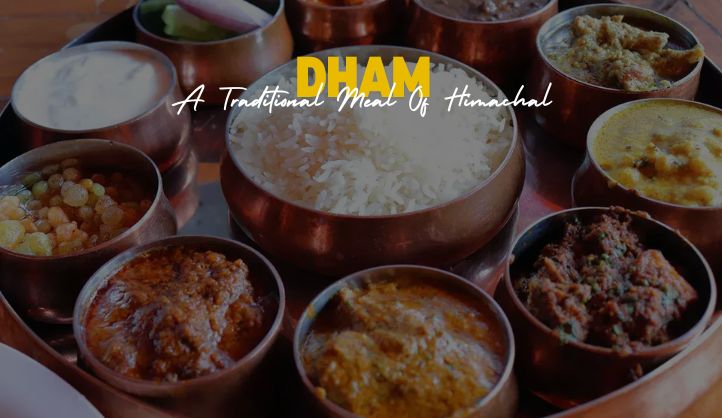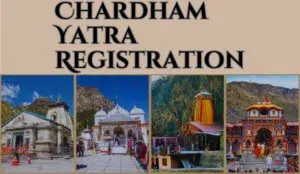Himachal Pradesh, a land of stunning mountains, green valleys, and vibrant culture, is also known for its delicious food. Among the many dishes and traditions, one stands out as a true celebration of Himachali heritage—Dham. Dham is not just a meal; it’s an experience, a tradition that brings people together, and a feast that tells stories of the region’s rich culture.
In this blog, we’ll take a deep dive into Dham—what it is, why it’s special, how it’s prepared, and what makes it such an essential part of Himachali life.
What Is Dham?
Dham is a traditional Himachali meal served during special occasions like weddings, festivals, and religious ceremonies. It’s a pure vegetarian feast cooked using local ingredients and recipes passed down through generations. What makes Dham unique is that it is served on banana leaves or pattals (plates made from dried leaves) and eaten while sitting on the ground, which adds to its charm.
The meal is not just about eating; it’s about connecting with the culture, the community, and even nature. Each dish in Dham has a special significance, and together they create a balance of flavors—sweet, sour, and savory.
The Story Behind Dham
The tradition of this dish dates back centuries. It is said to have originated in the Chamba Valley of Himachal Pradesh. According to folklore, the kings of Himachal Pradesh wanted their people to enjoy wholesome and delicious meals during festivals and celebrations. This led to the creation of Dham—a meal that is healthy, flavorful, and deeply rooted in the region’s traditions.
Dham is prepared by skilled cooks known as “botis,” who are experts in traditional Himachali cooking. These cooks are highly respected and often take years to master the art of making Dham.
The Components of a Dham Meal
A typical Dham meal includes a variety of dishes, each with its unique taste and purpose. Here’s what you can expect on your plate:
Madra
Madra is a rich and creamy dish made with soaked chickpeas or kidney beans, cooked in yogurt, and flavored with spices like cardamom, cinnamon, and cloves. It’s a signature dish that sets the tone for the entire meal.
Chana Dal or Mah ki Dal
This simple yet flavorful lentil dish is slow-cooked and seasoned with ghee, cumin, and coriander. It adds a hearty and comforting element to the meal.
Tudkiya Bhath
Tudkiya Bhath is a special Himachali rice dish cooked with lentils, vegetables, and spices. It is often served with a dollop of ghee on top for extra flavor.
Sepu Vadi
Sepu Vadi is a unique dish made from ground lentil cakes that are steamed, fried, and then cooked in a spinach-based gravy. It’s both nutritious and delicious.
Kadhi
Kadhi is a tangy yogurt-based curry thickened with gram flour and flavored with turmeric, curry leaves, and mustard seeds. It’s a perfect balance of tanginess and creaminess.
Boondi Raita
Boondi Raita is a cooling side dish with yogurt and small fried gram flour balls. It helps balance the spices in the meal.
Meetha Bhaat
Meetha Bhaat is sweet rice flavored with cardamom, saffron, and dry fruits like raisins and almonds. It provides a sweet ending to the meal experience.
Siddu
Siddu is a steamed bread stuffed with fillings like poppy seeds or groundnuts. While not a standard part of the meal, it’s sometimes included for variety.
Thukpa
Thukpa, though not traditionally a part of the meal, has become a popular addition in modern interpretations of the feast. This comforting noodle soup, with its Himalayan roots, is made with a flavorful broth, fresh vegetables, and spices. It provides a warm and soothing touch to the meal, especially during colder months.
How Is Dham Prepared?
Preparing this dish is no ordinary task. It involves meticulous planning and teamwork. The process begins early in the morning, with botis taking charge of the kitchen. The cooking is done in large brass or copper pots over wood-fired stoves, which gives the food its distinct smoky flavor.
The dishes are cooked one at a time, with great attention to detail. The botis ensure that the flavors of each dish are balanced and complement the others. Since this dish is a community affair, neighbors and family members often pitch in to help with chopping, grinding, and other preparations.
The Cultural Significance of Dham
This dish is more than just food; it’s a symbol of unity and togetherness. In Himachal Pradesh, sharing a meal is considered an act of love and respect. Dham is usually served after a religious ceremony, and it brings people of all ages and backgrounds together to celebrate.
What’s beautiful about Dham is that it reflects the simplicity and warmth of Himachali culture. The use of locally sourced ingredients and traditional cooking methods shows respect for nature and heritage.
Where Can You Experience Dham?
If you’re visiting Himachal Pradesh, experiencing Dham should be on your list. While Dham is traditionally served during weddings and festivals, many homestays, hotels, and restaurants in Himachal now offer it to tourists. Some popular places to enjoy Dham include:
- Chamba Valley: Known as the birthplace of Dham, Chamba is a great place to try an authentic meal.
- Kullu and Manali: Many local eateries and homestays offer Dham as part of their menu.
- Shimla: Some traditional restaurants in Shimla serve Dham during festivals.
Tips for Enjoying Dham
- Go with an Appetite: Dham is a multi-course meal, so make sure you’re hungry before you start.
- Embrace the Tradition: Sit on the floor and eat with your hands if possible. It’s all part of the experience.
- Savor Each Dish: Take your time to enjoy the unique flavors of each dish.
- Ask Questions: If you’re curious about a dish or its ingredients, don’t hesitate to ask. Himachali people love sharing stories about their food.
Conclusion
Dham is more than just food—it’s a celebration of Himachali culture, a tradition that brings people together, and a feast that leaves a lasting impression. Whether you’re a foodie, a traveler, or someone who loves exploring new cultures, experiencing the meal is a must when visiting Himachal Pradesh.
So the next time you find yourself in this beautiful hill state, make sure to sit down for a traditional meal. It’s an experience that will warm your heart, satisfy your soul, and give you a deeper appreciation for the simple joys of life.
FAQs About Dham
1. Is Dham only for vegetarians?
Yes, this meal is a completely vegetarian meal. It is traditionally served during religious and cultural events, which is why it doesn’t include meat.
2. Can tourists experience this meal?
Absolutely! Many hotels, homestays, and local eateries in Himachal Pradesh offer this meal, especially during festivals or on request.
3. How long does it take to prepare the meal?
Preparing this meal can take several hours, as each dish is made from scratch using traditional methods.
4. What makes the meal different from other Indian meals?
This meal is unique because of its cultural significance, traditional cooking methods, and the specific combination of dishes that create a balanced and flavorful meal.
5. Is the meal served in other states?
This meal is specific to Himachal Pradesh and reflects the state’s unique culinary heritage. While similar feasts may exist in other states, Dham’s flavors and traditions are distinct from Himachal.





